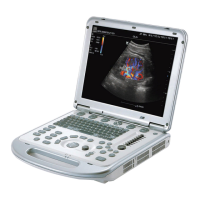11-2 Patient Data Management
11.2 Image File Management
You can store the image files either in the patient database in the system, or to external
memory devices. For a saved image, you can perform operations like image reviewing,
analyzing and demonstration (iVision).
11.2.1 Memory Media
System supported memory media including:
System hard disk
USB memory devices: USB flash drive, removable USB hard disk
DVD+RW, DVD+R, DVD-R, DVD-RW, CD-RW, CD-R
11.2.2 Image File Formats
The system supports two types of image file formats: system-relevant and PC-compatible.
System-relevant formats:
Single-frame image file (FRM)
Refers to single-frame static image files not to be compressed; you can perform
measurements and comments adding on this type of files.
Cine file (CIN)
System-defined multi-frame file format; you can perform manual or auto cine
review, and perform measurements or add comments for the reviewed images.
After you open a stored CIN file, the system automatically enters cine review
status.
The system can save FRM files as BMP, JPG, TIFF or DCM files, or save CIN files as
AVI, DCM files. The system can also open FRM, JPG, BMP and CIN files.
PC-compatible formats:
Screen file (BMP)
Single-frame file format, used to save the current screen, non-compressed
format.
Screen file (JPG)
Single-frame file format, used to save the current screen in the compressed
format; you can set the compression ratio.
TIFF: Single-frame export format

